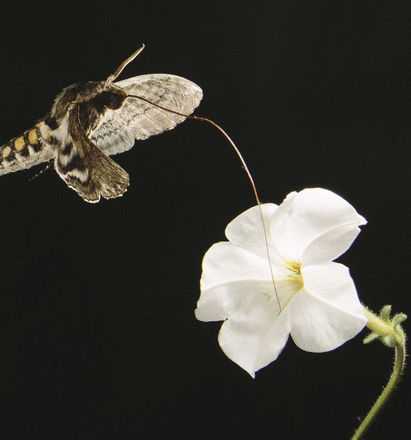PNAS封面:牵牛花花期的基因调控机制

本期PNAS封面:如图所示是一个Manduca sexta天蛾和佩妮矮牵牛花的不期而遇。很多开花植物限制他们的气味释放直到一个特定的时间,如佩妮矮牵牛在夜里释放它的气味。Myles P. Fenske等人发现生物钟基因的表达,这种基因在早上表达量到了峰值,抑制晚上表达气味排放基因。这个结果作为例子有节律生物钟调控基因调节植物代谢过程。图片由凯利Riffell摄影。
开花植物从他们的花瓣部分时会散发出香味来吸引传粉者。这种气味排放受到高度管制,往往是局限于一个特定的部分。尽管生产气味的生化途径的很有特点,我们所知的转录调控甚少。在这里,我们描述一个直接分子生物钟和花挥发排放之间的联系。我们发现一个时钟转录因子调节多种基因参与的调节矮牵牛花香发射时机。这项工作对气味的复杂但相对未知的转录调节生产提供了重要的见解,同时也揭示了如何调节昼夜节律钟的时间大量的代谢途径。
原文标题:Circadian clock GENE LATE ELONGATED HYPOCOTYL directly regulates the timing of floral scent emission in Petunia
原文摘要:Flowers present a complex display of signals to attract pollinators, including the emission of floral volatiles. Volatile emission is highly regulated, and many species restrict emissions to specific times of the day. This rhythmic emission of scent is regulated by the circadian clock; however, the mechanisms have remained unknown. In Petunia hybrida, volatile emissions are dominated by products of the floral volatile benzenoid/phenylpropanoid (FVBP) metabolic pathway. Here we demonstrate that the circadian clock geneP. hybrida LATE ELONGATED HYPOCOTYL (LHY; PhLHY) regulates the daily expression patterns of the FVBP pathway genes and floral volatile production. PhLHY expression peaks in the morning, antiphasic to the expression of P. hybrida GIGANTEA (PhGI), the master scent regulator ODORANT1 (ODO1), and many other evening-expressed FVBP genes. Overexpression phenotypes of PhLHY in Arabidopsis caused an arrhythmic clock phenotype, which resembles those of LHY overexpressors. In Petunia, constitutive expression of PhLHY depressed the expression levels of PhGI, ODO1, evening-expressed FVBP pathway genes, and FVBP emission in flowers. Additionally, in the Petunia lines in which PhLHY expression was reduced, the timing of peak expression of PhGI, ODO1, and the FVBP pathway genes advanced to the morning. Moreover, PhLHY protein binds to cis-regulatory elements called evening elements that exist in promoters of ODO1 and other FVBP genes. Thus, our results imply that PhLHY directly sets the timing of floral volatile emission by restricting the expression of ODO1 and other FVBP genes to the evening inPetunia.
作者:秩名

